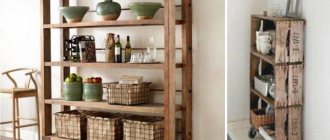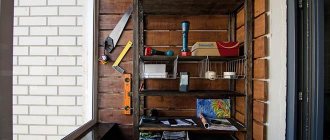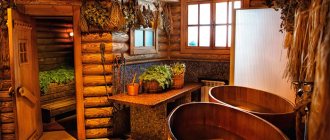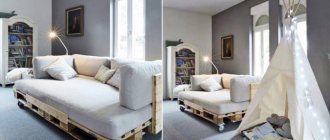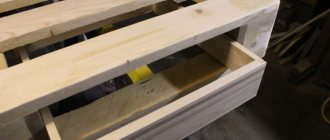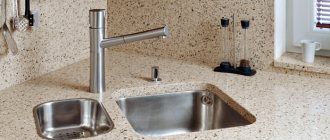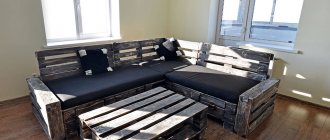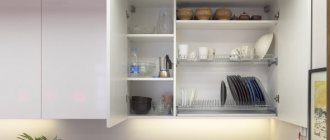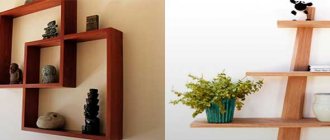Assembling a rack of pallets with your own hands is not difficult - all you need is a little free time, a little imagination and a minimal set of tools. Today we will tell you how to create different options for storage systems using construction pallets, otherwise called pallets, as the main material.
In our article you will find tips on choosing the pallets themselves, as well as step-by-step instructions for making various racks that will help you organize space in your apartment, workshop, office or country house. Let's get started!
Pallet rack - a budget and stylish solution
Simple wooden shelves
Wooden shelving in the garage
Most often, in garages, a simple stationary structure is made independently, located along one or two walls. In the latter case, it can be considered a corner.
This type of shelves has the following advantages:
- low cost compared to metal;
- simple and quick assembly without the need for metal processing (in particular, without welding);
- ease of maintenance;
- naturalness and good aesthetic qualities;
- with proper wood processing and care, a relatively long service life and high structural strength
An approximate view of such structures is given below.
Garage rack
The procedure for making such a structure is as follows:
- The materials from which the racks and the shelves themselves will be made are selected. Hardwoods (larch, oak) are suitable for racks, but, in extreme cases, ordinary pine can be used. The shelves themselves can be made from almost any wood material. Even plywood, chipboard or OSB can be used
- The racks should be made of timber with a cross-section of 10x10 or 5x10 cm. The cross members between the shelves are made from the same timber to give structural strength
- Shelves are cut from the selected material according to measurements
- All structural elements should be treated with an antiseptic before installation to avoid rotting or fungus
- The structure is assembled from racks and crossbars. If necessary, it is additionally reinforced with metal corners and attached to the wall, floor or ceiling
- The racks are marked vertically in the places where the shelves will be attached to them. Their fastening is carried out in various ways: self-tapping screws, tenons, and wood glue are used. In rare cases, dowels are used. Don’t forget about traditional nails, unlike self-tapping screws, they are less likely to come loose. To give extra strength to the shelves, they can also be mounted on metal corners
- After assembly, the ends of the rack are processed, and then the entire structure is varnished or painted
VIDEO: How to make a shelf out of wood
Shelves in the garage: order comes first. General design issues, simple options, step-by-step instructions for making your own (75+ Photos & Videos) + Reviews
Recreation area at the dacha: varieties and options for arranging it yourself (65+ Photos & Videos) + Reviews
Where can I get pallets?
Wooden pallets, although they are quite durable structures, are still considered by many manufacturers and transport companies as packaging material.
Pallets weakened by load cannot be reused for transporting heavy loads, so after use they are simply disposed of
You can obtain used packaging material using one of the following methods:
- Buy used pallets. You can easily find advertisements of this kind on thematic portals. The price of products ranges from 30-150 rubles per piece.
- Contact manufacturers or transport companies directly. Most of them are ready to give away used packaging for free, just so as not to throw it away themselves.
If desired, you can assemble the pallet yourself. It is enough just to stock up on boards with a thickness of 15-20 mm and wooden beams with a cross-section of 60-70 mm. Having determined for yourself the dimensions of the future structure, you only need to cut the boards into blanks of the required sizes, and then fasten the elements together according to the standard pattern.
We make flower stands with our own hands, what materials can be used
To create such structures, you can use the following materials:
- plastic;
- metal;
- glass;
- tree;
- wire;
- combined raw materials.
Metal structures are considered durable and can support large pots. The stand looks very presentable and solid.
The plastic shelf is lightweight and versatile. Sections are freely removed and moved. The material does not require constant maintenance and is not afraid of water, and has a variety of colors. Plastic is quite flexible, so the racks can be given any shape, appearance and size.
It is difficult to build such a structure yourself; it requires certain skills.
Wooden shelves are more often used, although they are the least practical and durable. When watering a flower, water can get on the wooden base, which will subsequently cause swelling and rotting of the material.
To avoid this, the base should be treated with paint and varnish material and not install the structure in areas of the house where there is a lot of moisture.
Glass coasters look elegant and stylish. However, such a structure requires professional skills and constant care. Glass will not support much weight, so it is used only for small plants, and no more than two pots.
The wire must be thick. Use only for non-bulky, lightweight stands. Elegant compositions are performed in various styles. Used for indoor and outdoor spaces.
For combined sections, several materials are used simultaneously, for example: wood and metal, plastic and glass.
The structures can withstand a lot of weight and are well suited for home decor.
The choice always remains with the owner, after weighing all the pros and cons, you can start working.
Simple and fast
The easiest and fastest option to implement is a shelf in the form of a ladder. The photo below shows an example.
You will need:
boards or thick plywood; wood screws; drill; saw; pencil; ruler; special glue for wood products; sandpaper; paint or glaze on wood
Just make sure that they are intended for interior work.. First, decide what width and height your product will be, how many shelves you want to place
Use a pencil and ruler to mark the required dimensions and cut the required parts.
First, decide what width and height your product will be, how many shelves you want to place. Use a pencil and ruler to mark the required dimensions and cut the required parts.
Now on the racks you need to mark the places where the shelves are attached. Since our shelf-ladder will be placed against the wall, it is necessary to take into account the inclination of the shelves. It will also be necessary to cut at an angle the side of the racks that will stand directly on the floor. This will give greater stability to the structure.
It is better to mark the places for screwing in the screws with a drill. Then coat the surfaces with glue and assemble the bookcase. Now you can start painting.
A couple of painting tips:
- If you want the same product as in the photo, then choose a paint with more covering power. For example, universal enamel. Some craftsmen impregnate the wood with a special oil to create the effect of wood that has not been painted. You can also tint the material, which will even help “change” the type of wood;
- If your shelf will be used in a dry room, then there is no need to prime it.
Related article: Irish lace dress with patterns: master class with photos
This shelf is suitable for books and magazines, framed photos, flowers, etc.
Assembling a simple rack from pallets
This option is suitable for any room and has a universal purpose. The versatility of the rack is explained by the fact that it consists of many shelves, the size and number of which can be varied independently.
What you will need for production:
- pallets;
- saw (manual or electric);
- sandpaper;
- paint or varnish;
- metal plates with holes for self-tapping screws;
- self-tapping screws;
- hooks for clothes;
- furniture nails;
- small roller or brush.
Self-tapping screws
Step-by-step manufacturing instructions
Step one: saw off one element from the pallet along the yellow notches shown in the figure. This part will become the future shelf.
Saw off the elements
Step two: you should get a blank for the shelf, which it is advisable to try on to the place where it will be located. In order to get several shelves, which can then be combined, repeat the first step as many times as necessary.
Blank
Step three: cut two more boards from the remaining part of the pallet. They will be the same width as the boards in the workpiece.
Saw off 2 more boards
Step four: adjust the length of the sawn boards to the length of the existing workpiece. The elements will be joined as shown in the figure.
Adjust to length
Step five: the workpiece and boards must be carefully sanded so that they are smooth and free of nicks. You can use sandpaper or a sanding wheel if you have a sander.
Sand the workpieces
Step six: paint the blanks in the desired color or varnish them. Dry it.
Painting the workpiece
Step seven: we begin assembling the structure. We screw two fastening plates to one board so that half remains free (to connect the board and the shelf blank together).
Screw the fastening plates
Step eight: turn the workpiece over and attach the board joint to joint, screwing in the screws.
Fastening the boards end to end
Step nine: attach the second board to the bottom of the future shelf so as to close the void below (we make the bottom of the shelf). We nail the board with small furniture nails. Use enough fastening material, otherwise the bottom will not support the load.
Making the bottom of the shelf
Step ten: onto the front side of the bottom board, which we attached in step eight, we screw coat hooks.
Attaching the hooks
Step eleven: on the back of the mini-rack we place fasteners to hang it on the wall. The work is done. If desired, you can connect several of these structures to get a larger storage area.
Finished shelf
Video - Do-it-yourself mini-rack made from a pallet
How to make a regular wooden shelf with your own hands
In order to make a tool rack with your own hands, you need to take appropriate measurements to determine the size of the structure. It is recommended to draw up a drawing that will contain the exact layout, dimensions, tools used and step-by-step execution of the work.
Take all the necessary measurements in the room to determine the dimensions of the future shelf.
When drawing up a sketch, you need to consider the following parameters:
- The distance between adjacent shelves is about 40 centimeters;
- The width of the rack should be no more than half a meter so that you can easily get the necessary tools;
- The distance from the bottom shelf to the floor must be at least 80 centimeters;
- The length of the shelf should be from one and a half to two meters.
The maximum depth is 50 centimeters; if it is more, it may be difficult to access tools and necessary items.
The second stage is the choice of design. Now let's look at a master class on installing garage shelving using bolts.
To do this, you will need the following tools: hammer drill, drills, bolts, drill, boards and metal corners. You will also need a tape measure, a pencil or marker, a tape measure and finishing material.
Wood requires simpler skills to work with it, the same goes for tools.
Now you need to decide on the number of shelves. You shouldn’t make too many of them, as the entire structure may not support too much weight.
You can start assembling the frame without shelves. Markings are applied to the racks and holes are drilled for greater reliability.
Apply the required markings on the racks if your structure is placed on the floor, and drill holes to secure the frame.
Now you need to connect all the parts. Attach boards, pre-cut to the appropriate size, using bolts and angles. For greater stability, attach the shelf to the wall.
Connect the elements and install a solid structure. If necessary, secure it to the wall.
Time for the final stage - finishing. It is recommended to use varnish for wood and stainless steel for metal. This will not only make the rack attractive, but will also improve some properties.
Materials and tools for work
Working on creating crafts from pallets for a dacha, home, or summer terrace will require the master to prepare the following set of tools:
- Jigsaw and grinder (if you plan to work with metal parts).
- Fasteners (metal corners, self-tapping screws, screws).
- Compositions for impregnation of wooden surfaces (moisture-repellent oil, antiseptic and antifungal solutions).
- Planer and sandpaper for sanding surfaces.
- Decorating compositions (stain, paint and acrylic varnish). Applying several layers of decor to the surface of the wood creates additional protection against rot and pathogenic fungus.
- Measuring tape, tape measure and construction pencil.
Be sure to prepare drawings of future products and crafts in advance.
Useful tips
It is not difficult to make shelves in the cellar with your own hands; it is much more difficult to keep the rack intact in the difficult conditions of this underground room. To avoid finding your cans of preserves on the basement floor one “fine” day, you should adhere to the following rules:
- control the operation of the cellar ventilation system; the microclimate and humidity of the basement depend on high-quality ventilation. It has been noted that it is natural (supply and exhaust) ventilation that better regulates the temperature and humidity of the cellar, so it should be given preference over artificial systems.
- Shelves that are aired every year last much longer, rot less, and rust more slowly.
- The wood of the shelves is regularly inspected for rotting. If pockets of rot are found, the shelves in the basement should be disinfected and antiseptically treated.
- Homemade shelves may not support the weight of the cans, so food items on the racks need to be spaced evenly.
- If the basement is very damp, you need to whitewash the walls and ceiling with slaked lime several times a year.
- You should not make shelves wider than 0.75 m, in which case they will sag and you will have to build supports.
Important! Typically, racks and shelves with jars are located to the right of the entrance to the basement, on the left there are bins with potatoes and other vegetables
Building shelves for cans of preserves is quite simple: it can be made from scrap materials using simple tools. In order for racks and shelves to serve for a long time, it is necessary to fulfill all the requirements listed above and follow the recommendations given. You can visually familiarize yourself with the process of building shelves for a cellar using photos and videos:
How to prepare pallets for rack assembly?
Before thinking through the design of the future rack, and even more so assembling it, it is necessary to carry out some preparatory work. It will be convenient to do this not in an apartment, but on the street (weather permitting), in a garage or workshop - the preparation will be dusty.
Step-by-step instructions for handling pallets
Step one: clean the surface from dirt and dust, as well as rough areas of wood. For this it is better to use a grinding machine. Be sure to wear gloves, a protective mask and goggles to prevent sawdust from injuring your hands or getting into your eyes!
Surface cleaning
Step two: when the rough processing is done, you need to bring the wood to a smooth state. It is convenient to do this with fine sandpaper. Thoroughly sand all surfaces of the pallets that will “look” outward. It is not necessary to sand the inside of the pallets. To make the job easier, a sandpaper wheel can be placed on the same sander.
Sanding surfaces
Step three: if the rack will be located outdoors or in a room with low temperature or high humidity, you need to treat the wood with a special moisture-repellent and antifungal impregnation. There are transparent or colored options - choose at your discretion.
Impregnation treatment
Assembling a wall rack from two pallets
This option will be a good way to store outerwear, and is also suitable for placing books, magazines, flower pots, children's toys or any other items.
What you will need for production:
- two pallets;
- three flat wooden slats;
- six wall mount brackets;
- roulette;
- hand crowbar;
- hand saw;
- sander, sandpaper;
- self-tapping screws
Step-by-step manufacturing instructions
Step one: first you need to dismantle the top part of the pallet. To do this, carefully insert a crowbar into the gap between the boards and swing it to pull out the nails.
Removing the top part of the rack
Step two: boards are sawn off from the top of the pallet. To create a rack you will need nine boards 120 centimeters long, four boards 50 centimeters long, two boards 30 centimeters long.
Preparing the boards
Step three: all elements must be thoroughly sanded using sandpaper or a sander.
Grinder
Step four: lay out all the 120-centimeter boards closely - they will be the basis for the rack. To make the finished product look more interesting, you can move the boards up and down one at a time, getting curly edges.
Move the boards one at a time
Step five: install three slats perpendicular to the pallet boards and carefully screw them onto the screws so that the slats are attached to each board.
Screw the slats
Step six: turn the workpiece over to the front side and install the bracket holders at three different heights. Later, boards will be attached to them, which will serve as shelves for the rack.
Installation of bracket holders
Step seven: attach 50-centimeter boards in pairs to two pairs of brackets - there you can increase the area of the shelves.
Installing shelves
Step eight: attach two 30-centimeter boards to the remaining pair of brackets - they will act as a small shelf.
Installing a small shelf
Step nine: the finished rack can be painted in the desired color or varnished. Hang fasteners are attached to the slats on the reverse side to secure the shelving unit to the wall.
Ready rack
Selection of materials
The most difficult thing is still the choice of design, because everyone’s wishes can be very different, and there are a huge number of options.
The choice of materials is another matter. Almost all shelving is made from two types of materials - wood and metal. In the first category we include not only traditional wood, but also fiberboard, chipboard and other derivatives.
Only you can decide how to make a rack with your own hands, but you should choose the material wisely, and therefore we will analyze each of them.
Let's start with metal
Metal is a durable material that does not burn, which is especially important when creating a shelving unit for a garage.
On the other hand, not everyone knows how to work with metal, but this is only if we talk about the traditional understanding of the issue.
Nowadays, the simplest shelving is often assembled from profiles, construction corners and similar analogues. Such designs turn out to be very practical, lightweight, but not very beautiful in terms of design.
Such a rack is perfect for a garage, but there is one condition - control of the weight of everything that will be stored on it.
Construction profiles are used to create false walls, various structures on the ceiling and walls. The load on them is not very large and this must be taken into account.
Having placed one in the garage, you should be prepared for the fact that it is better not to put sets of rubber on it, like other heavy tools.
Just imagine your reaction when you go into the garage in the morning before work and find a rack and all its contents dumped on your car - there will be very little pleasant in this.
Wood in almost every sense looks more interesting than metal, if we are talking about self-creation. Let's say you are thinking about how to make a rack for seedlings yourself, because you are growing vegetables.
In this case, you will need a wooden beam for the frame and simple boards for the shelves.
This is what the simplest wooden shelving design looks like. In this case, the tools you will need are a hacksaw, a tape measure, a hammer, and nails. The last items can be replaced with a screwdriver and self-tapping screws, if available.
You can put the same wooden rack with your own hands on a loggia for storing various things, in a storage room for conservation, or in a cellar for the same needs.
In addition, wood fits perfectly into almost any environment, and if desired, the color can be slightly changed using varnish or paint.
Let's sum it up
Assembling any furniture from pallets is a fun activity. It is even more interesting to assemble a shelving unit from pallets, because this element of the interior is not as demanding on the exact dimensions or shapes as a bed or table, and you can show all your imagination during the work. Thus, you can shorten or lengthen the models we offer (the latter option can be “stretched” even across the entire wall, creating a unique decor for the space).
We recommend that you take ideas for creating shelving from pallets as a basis, change them and modernize them to suit your needs and the characteristics of the room. Good luck!
Manufacturing technology
So, let's look at the simplest DIY chaise lounge you can think of. For a dacha - a win-win option.
List of materials:
- 4 equal-sized rectangular pallets;
- 1 pallet is slightly wider than the others, square;
- boards – 50 by 100 m.
This is with the expectation that there will be a couple of sun loungers.
Algorithm of actions
- 4 pallets must be taken and placed in pairs on top of each other. Two at a time. There is no need to fasten them yet, the weight will hold them together without that.
- You should make sure that the square remaining tray is wide enough to turn into a backrest. It’s worth remembering that the pallet includes 3 layers - top, middle and bottom boards, between which air flows. The top ones should be long for a full back, and you will also need to attach a 50 by 100 mm board to them on each side.
- Disassembling the back tray: all bottom boards need to be removed, as well as the 2 outer middle boards. One or two boards in the middle will have to be left so that nothing threatens the stability of the upper boards. But you shouldn’t throw away waste in the form of removed boards - they will still be useful.
- The remains must be cut into 2 parts. It’s time to attach a 50 by 100 mm board to the top layer on both sides. These boards must be longer than the sides of the back (otherwise they will not be able to attach to the pallet).
- The backrest should be leaned the way the owner of the bed wants to see it in the final version.
- All that remains is to attach the backrest to the seat. Some people simply tie it down, but such a structure can be awkward and shaky. Therefore, it is better to fasten the structure with screws on both sides.
- The bed itself is ready, now it’s time for finishing work. Ideally, the tree should be primed and painted in a color that will harmonize with the site. If there is a kind of beach on the site (near a pool or pond), the lounger automatically becomes a beach one, and the bright colors of this design are more suitable.
Typically, such sun loungers are covered with mattresses and blankets or bedspreads. In bad weather, these deckings are removed into the house.
The next example is a curved chaise longue made from pallets; its design may seem a little more complicated than the previous one. But the drawing shows that there is nothing impossible here.
For this sun lounger you will need:
- 3 euro pallets;
- 2 boards 60 cm by 3 cm by 4 cm;
- acrylic varnish of a suitable color;
- 4 brass square corners;
- 4 brass rectangular corners;
- 80 universal screws;
- sandpaper;
- hacksaw or hand circular saw;
- screwdriver (preferably cordless).
Let's look step by step at how to make a curved lounger quickly.
- To begin with, the pallets need to be thoroughly sanded. First, go over them with the coarsest sandpaper, then reduce the grit of the paper and go to the finest one.
- You should take your own measurement - from the foot to the knee, and then divide 2 pallets by this measurement. One part will go to the foot, and the other will make an excellent seat. The short part of the second pallet will become supports, and the third pallet will rest on them.
- The individual parts of the first pallet must be installed vertically and secured at the angle that is most convenient for the manufacturer. The bottom boards will have to be shortened according to the length of the seat.
- If the seat is placed against the foot, it will be clear that the sawn ends need sanding. Now it's time to secure both parts with brass screws (large and small).
- An additional board must be placed on the pads of the seat and footboard. Protruding boards are sawed off after marking. Now you can screw the boards using screws. The pallets are turned over and the same actions are repeated on the other side.
- Now the third, still a whole pallet, is placed on its side. Using brass corners, a short fragment of the board (the one that was sawed off from the second pallet) is screwed to the upper half. The tilt of the future bed depends on the position of the corner. Almost ready, by the way.
- All that remains is to paint the foot and bottom of the chaise lounge with tint varnish. As soon as it dries, the structure can be assembled - it will not be difficult.
By the way, there is no need to screw all the elements of the sunbed. Some are held calmly by their own weight; individual parts will then be easier to move if the chaise longue “migrates” around the area.
You can be puzzled and make a combined design - a large and hospitable garden sofa, which with a slight movement of the hand can be divided into a narrow sofa-bench and a couch. At the very least, this idea is worth thinking about.
How to make a sunbed for a country house from two pallets is shown in the video.
Nailing the bottom of the shelf
At this stage, fragments of the pallet removed from the central part will be used. They must be attached to those parts of the pallet that will later become the bottom of the shelf. It is allowed to use those nails that were previously on the pallet, but if their condition leaves much to be desired, then it is better to purchase new ones.
Nailing the bottom of the shelf
Return to content
Features of assembling metal shelving
Metal racks can be welded or assembled with bolts. There are usually no problems with welding. If a corner is used, the joints can be overlapped - a difference of 3-5 mm when laying shelves is unnoticeable. If you wish, you can cut out the excess in one of the shelves and butt weld, but trimming takes a lot of time, and you still won’t see much of a difference.
How to cut corners for a smooth connection
When assembling a frame for a bolted shelving, the order is as follows: first, assemble the squares of the sidewalls and shelves separately, then screw them together. It is advisable to have at least two bolts for each connection - for greater rigidity (less play).
If you assemble garage racks from a profile pipe with your own hands, the procedure is different. First, the sidewalls are assembled, and short crossbars are attached to them. You get two rectangles with crossbars. Then they are connected by crossbars.
Methods for bolting profile pipes
See the photo for how to make connections. In one case, welding is still needed - weld the heel pad, in another you can do without it - cut out the "ears", bend them and cling to them.
There is another way - special crab systems. These are metal plates with recesses molded to fit the profile. Pipes are placed into the grooves, then the two plates are bolted together.
Crab systems for profile pipes
Such a connection is unlikely to withstand very heavy loads, but there is an undeniable advantage - you don’t have to drill a bunch of holes in the metal. In a profiled pipe this is certainly easier than in a thick-walled corner, but it still takes a lot of time and effort.
By the way, the bolts used are M8 or M6, so large holes are required for them. It is easier to first drill with a thin drill, then expand to the desired size with a thick one. But even with this order, you will need a significant number of drills. To make them overheat less and break less often, place a jar of water nearby and periodically lower the drill into it.
Welded
Used to create large metal shelving. It has impeccable reliability and the ability to withstand even the most severe loads. Most often, shelves of this type are used to store large items.
There is one significant drawback - during redevelopment, it is often not possible to fit such a rack into the new space due to the non-demountable design. So if you love change, there is reason to think about choosing a different type.
Bolted
The main advantage of such a shelf is mobility. All parts are bolted together and can be easily dismantled if necessary. However, even with perfect assembly, there may be some play at the connection points. It is either present immediately or appears over time under the influence of the mass stored on the shelves.
The disadvantages of this design can be overcome by fixing it to the walls.
Combined
Typically found in spacious garages and technical rooms for car repairs. Most often it is formed through the so-called build-up - when there are more and more tools and storage items, but there is no other place for a new shelf and is not expected.
Sources
- https://www.yaprofi.net/polki-svoimi-rukami/
- https://stroychik.ru/garazh/polki-i-stellazhi-dlya-garazha
- https://www.asusfone.ru/svoimi-rukami/samodelnyj-stellazh-dlja-hranenija-v-sadovom-sarae-iz-staroj-mebeli
- https://postroika.biz/24568-stellazh-iz-dereva-svoimi-rukami.html
- https://garazhmechty.ru/polki-v-garazhe-svoimi-rukami.html
- https://1dacha-sad.com/delaem-stellazh-dlya-garazha-svoimi-rukami
Published: 06/11/2020
Step-by-step instruction
Step 1. Cut the lining, adjusting its length in accordance with the length of the rack. If the planks you bought are longer than the width of the structure, then the excess needs to be carefully cut off.
Trimming parts according to the length of the future rack
Step 2. Treat the surface of wooden products with impregnation, thereby protecting them from external factors.
Next, protective impregnation is applied
Impregnation application process
Step 3. Paint each of the structural elements. To save time, you can lay several planks together at once and paint them as one surface. Then turn them over to the other side and continue painting.
Convenient to process several boards at a time
Step 4. Once all the parts are painted, leave them outside until completely dry. The impregnation does not smell very pleasant, so it is not recommended to dry painted products indoors.
Wait until the wood is completely dry
Step 5. Make marks on the bars in the places where future shelves should be located. Then install metal corners in the designated places. If you have a screwdriver in the house, this will significantly speed up the work process.
Metal corners fixed
Step 6. Install the lower horizontal elements to create an “H” shaped structure. As a result, you need to make four such products.
There should be 4 such elements
Step 7. This is what the rack design should look like at this stage of manufacturing. She is not very attractive yet, but this can all be fixed.
Making a rack with your own hands
Step 8. Fasten the first shelf, or rather, the boards of the first shelf to the horizontal bars. It is not necessary to use screws for this - you can get by with ordinary nails.
Installing the first shelf using nails
Step 9. Start nailing the outermost board first, which will be visible to everyone. Here it is necessary to choose high-quality material, without defects. After installing all the elements, the bottom shelf will be ready.
Finished bottom shelf of the rack
Step 10. Make small stands for the legs of the structure being manufactured, thereby protecting the floor covering from mechanical damage. In addition, if you add a few laminate scraps, they can be used to level the rack in the future.
Stands for shelving legs
Step 11. Proceed to make the second shelf of the rack. All actions should be similar, only at this stage of work you can immediately install the upper horizontal lines.
Installation of the second shelf
Step 12. Make sure that the shelf, or rather, the planks from which it is made, lie on all horizontal lines. Ideally, all these elements should be in the same plane.
The boards must lie on all horizontal lines
Step 13. If there are large gaps between the shelves and horizontal bars, level them using small pieces of laminate. Simply cut out a strip and place it under the board in the desired location.
This gap needs to be corrected
Step 14: Do not screw the side of the square that attaches to the upright too tightly. When eliminating too large gaps, the horizontal will need to be moved a little. Once everything is level, screw the fasteners as tight as possible.
One part of the corner is not fully screwed
Step 15: Install the last shelf, making it slightly wider than the others. If the first two shelves use 5 planks, then the top one should have 6. This will increase the strength of the entire structure.
DIY rack is ready
Additionally, you can make a small ladder if the rack is high enough. The design of the staircase may vary. Now everything is ready and you can enjoy the result of the work done.
Assembling an unusual shelving unit from pallets
Below we offer you instructions on how to create a creative shelving unit that will become a decoration in itself for any room. This bookcase is suitable for placing books, newspapers or magazines, audio or video discs, as well as small decorative items. If you screw a bracket to the front of the rack, it can become a decorative design for a flat-screen TV.
What you will need for production:
- pallets;
- sandpaper (medium and fine);
- short furniture nails;
- roulette;
- hand saw or hacksaw;
- sander;
- hammer;
- hand crowbar;
- screws and a screwdriver.
Step-by-step instruction
Step one: First, carefully remove the boards from the pallets. To do this, you need to carefully push the crowbar into the cracks between the boards and swing it to pull out the nails.
Removing the top part of the rack
Step two: Using a sander or by hand with medium sandpaper, sand the wood to give it a smooth texture. It is better to sand the wood thoroughly at the stage when the boards are disassembled - it is easier than sanding already inside the shelving elements.
Sand the wood
Step three: saw part of the resulting boards in such a way as to obtain twenty-four blanks approximately 20 centimeters in length. These blanks will serve as shelves, so they need to be thoroughly sanded again with finer sandpaper.
Please note that the width of the boards depends on the type of pallet itself, so it is difficult to give an exact figure - rely on the material you have.
The length of your workpieces should be twice the width of the boards from the pallet
Step four: now you need to cut several boards into twelve pieces 25 centimeters wide. The rack will include blocks of different types: two larger blocks (just 25 centimeters wide) and six smaller blocks (their width will be equal to the width of the pallet boards - about 10 centimeters).
The rack will include blocks of different types
Step five: Let's start by assembling larger blocks. Measure the long boards from the pallet and make a mark in the middle. Nail a piece 25 centimeters long to each end of the board with nails; the same piece should be nailed in the middle of the board.
We nail the blanks
Step Six: Nail a second long board on the other side to create a long rectangular section with a shelf in the middle. Then make three more of the same “frames”, performing the steps described above.
Ready-made large blocks
Step seven: now let's start creating smaller blocks. Place the two boards together, aligned and as close as possible. Then measure the boards and divide them into three equal lengths. Nail small pieces to the ends of the boards, two more pieces need to be placed inside the section, as shown in the picture below. On the other side, attach two more long slats.
Small block assembly
Step Eight: Repeat step seven a few more times to complete the remaining small sections. Then connect one of them to the first. For greater originality, nail the second section, slightly moving it upward.
Ready-made small blocks
Step nine: start attaching the finished larger section to the small sections using self-tapping screws.
Fastening the large section
Step ten: to make the structure symmetrical, nail one long strip to the very bottom, which will help you orient yourself to the lower border of the shelf when assembling. When you are finished, remove this auxiliary rail.
Nail the board on one side for guidance.
Step Eleven: Continue assembling, varying the different sized sections as you like.
Make sure that the structure has at least three points of support
Step twelve: turn the resulting product over. If desired, the rack can be painted or varnished.
Ready rack
Modular shelving
Do-it-yourself wooden racks are made from solid wood. The structures have increased strength and stability. Along with wood, plywood is used to assemble shelf structures.
The material provides ample opportunities for assembling decorative modular shelving, made in eco style for vegetable boxes, minimalist boxes with different geometries for a separate arrangement or combination of an ensemble.
The first step in making a modular shelving is to develop a scheme for connecting individual niches into a complete structure.
Based on the dimensions of the product, the required amount of plywood is calculated and the parts are cut.
How to make a rack with your own hands from wood or plywood to hide the presence of fasteners? Assemble using dowels or countersunk screws, which are masked with wooden plugs.
Final sanding prepares the surface for paint application.
At the end, the hinges are screwed on and the elements are ready for use.
Photo gallery: products made from wooden pallets
An easy-to-make sofa: a tray, wheels, soft pillows One pallet is enough for such a coffee table Paint it in the desired color, apply an interesting design - and the new coffee table will harmoniously fit into the interior Just one pallet, and your shoes have their own convenient place Comfortable, practical and inexpensive swings made from pallets
You can make beautiful flower stands from a couple of pallets
There must be a bench in the garden plot, and pallets are an excellent material for it!
From pallets you can make a rack for storing books and all sorts of small items
This comfortable set of table and chairs will look great both in the kitchen and on the outdoor patio.
Very convenient bedside table on wheels for TV
Herringbone bookcase
The non-standard arrangement of shelves scares beginners, but assembling a wooden shelving rack with your own hands in the form of a Christmas tree is much easier than it seems.
To assemble a cantilever type rack with missing side walls, we will need a 15 mm furniture board. If a transparent coating will be used, choose an extra grade without visible defects. Paint coating allows the use of lower quality grades.
We cut out the supporting base from the shields. To further stabilize the rack, the base can be attached to a frame made of timber. We attach the back wall to the base.
Cut the shelves to the required size. The parts are attached to each other at an angle of 90 degrees. When assembling, it is better to use a square. To ensure base stability, the shelves are twisted together and screwed to the back wall.
The disadvantage of such a rack is its compact size, since the design features do not allow for the assembly of large-sized products.
Preparation
Before making furniture, purchased pallets will need to be carefully prepared:
- The wooden surface is cleaned with a grinder or sandpaper. It is better to do this in the fresh air or in a well-ventilated area.
- Pallets are disassembled into boards , this will make it much easier to work with the material.
- It is recommended to sort the disassembled boards by size, as they will have different lengths and widths.
Description of species
Depending on the place of use, racks are divided into two large categories.
Racks for boxes
Gravity racks for boxes are used when goods are stored in plastic containers. In such a situation, the cargo from the loading zone is sent to the shelves, where, under the influence of gravity, it gradually moves to the unloading point. Such shelves can also be placed on ordinary racks, which guarantees dynamic storage of goods.
Pallet racks
Cylindrical rollers installed in the channel of the gravity rack are responsible for the longitudinal movement of the load. There are also brake rollers that determine the speed of movement. When the first pallet reaches the stop, the movement is automatically interrupted.
Recommendations for placing shelving
Installation of stationary shelving can be done in the kitchen, pantry or garage. Large open shelves provide great visibility. In this case, all items are easily obtained and just as easily returned to their place. It is better to install a closed shelving unit in a children's room or living room. For example, you can store a large number of books or toys there. The baby will be able to store his things in such a rack.
Kitchen shelving
Rack partition
If we talk about the rotating structure, then it can be installed almost anywhere, be it a children's room, a garage or a living room. The rack is more complex to make, and you also need to learn how to decorate it, because if you install the product in the middle of the living room, it will always be in sight of guests.
Sizing
As mentioned earlier, the dimensions of the rack depend directly on the dimensions of the room
To make shelves in a closet in an apartment, it is important for a home craftsman to consider several parameters before drawing up a diagram:
- width, length and height of the pantry - for the basic layout of the drawing;
- convenient access to the shelves and low height of the rack - for comfortable use of the product without the use of stands and ladders;
- the expected number of items that will be stored on the rack, their sizes, from height to width;
- load capacity - the higher it is, the more stiffeners there should be to ensure the strength of the structure;
- The slope of the floor is an important parameter, without taking it into account you can get an unstable product.
Based on the listed parameters, the home craftsman should sketch out the most detailed drawing, or take a ready-made diagram and substitute his own dimensions. Such a thorough and responsible approach will bring successful carpentry results.
Important! If the floor is uneven, then both stands for the shelving supports and additional fastening of the shelves to the wall of the pantry can help. The load capacity of the rack directly depends on the distribution of load on the shelves
The load capacity of the rack directly depends on the distribution of load on the shelves
Types of structures, photos
After you have chosen high-quality pallets for making a rack, it is worth considering the type of construction of the future furniture item.
Let's look at the photo. The most common models are:
- Floor-standing. Such products are distinguished by strength, spaciousness, stability, and massiveness. They are permanently attached to the wall, and without first dismantling they cannot be moved to another location.
- Mounted. They consist of several shelves (3-4 pieces) and are suitable for small spaces. Their advantages include compactness and ergonomics, which allows you to save free meters in the room.
- Mobile (on wheels). They are lightweight, compact and equipped with furniture wheels for ease of movement. This option is suitable for people who like to frequently rearrange the room.
Photo of the finished shelf
Photo of the finished shelf 1
Photo of the finished shelf 2
Photo of the finished shelf 3
Photo of the finished shelf 4
Return to content
